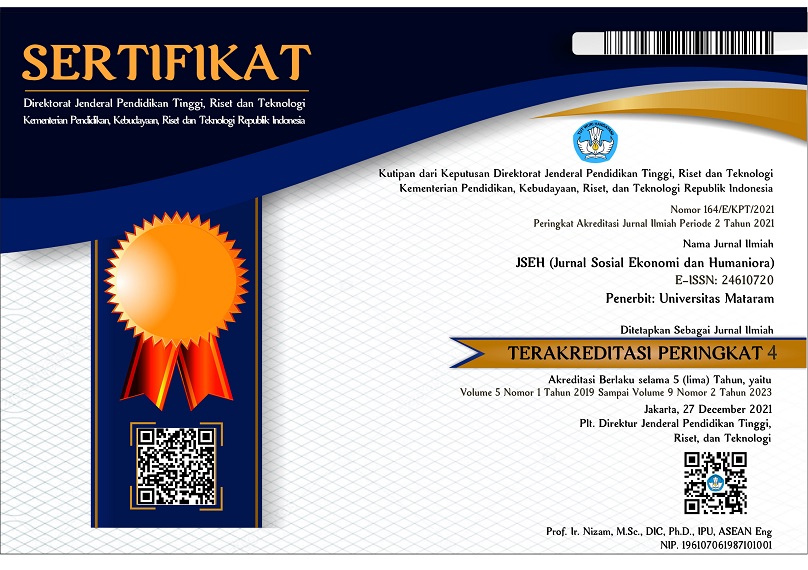Upaya Peningkatan Pendapatan Nelayan di Desa Wisata Buluh Cina Melalui Pengelolaan Budidaya Keramba Ikan
DOI:
https://doi.org/10.29303/jseh.v11i2.809Keywords:
Fish farming, fishermen’s income, linear regression, business effectivenessAbstract
Fish farming in floating cages has become one of the primary sources of income for fishermen in the tourism village of Buluh Cina. However, various challenges such as fluctuating selling prices, limited capital, and environmental factors continue to affect the effectiveness of this business. Therefore, this study aims to analyze the effectiveness of fish farming management in supporting the economic sustainability of fishermen and identify the factors influencing their income. This research employs a quantitative approach using a survey method. The study sample consists of 128 fishermen engaged in fish farming, selected through purposive sampling. Data analysis was conducted using multiple linear regression to examine the effects of harvest quantity, production costs, and selling price on fishermen's income. The results show that selling price has the most significant and positive influence on income, while production costs have a significant but negative effect. Harvest quantity shows a positive influence but is not statistically significant. These findings highlight the importance of efficient cost management and appropriate pricing strategies in increasing fishermen’s income. In conclusion, fish farming in keramba holds great potential for supporting the economic sustainability of fishermen, although issues such as cost efficiency, price fluctuations, and production management still require further attention.
References
Adrian, R., Lubis, M., & Sari, Y. (2023). Analisis fluktuasi harga dan pengaruhnya terhadap pendapatan pembudidaya ikan air tawar. Jurnal Sosial Ekonomi Perikanan, 15(1), 55–63.
BIG. (2017). Atlas Nasional Indonesia. Badan Informasi Geospasial.
Davis, J., & Robinson, P. (2018). Aquaculture Technology Innovation and Impact in Southeast Asia. Marine Policy Journal, 93(2), 114–120.
Gunawan, T., Sari, P., & Fauzi, H. (2018). Kolaborasi pemangku kepentingan dalam pengembangan budidaya ikan air tawar berkelanjutan. Jurnal Pengembangan Wilayah, 4(3), 223–235.
Hamid, A., Pranowo, W. S., & Sukardi. (2020). Analisis usaha budidaya ikan air tawar di keramba. Jurnal Sosial Ekonomi Perikanan, 15(2), 117–126.
Maulana, R., & Fahlevi, M. (2019). Efisiensi biaya produksi dan dampaknya terhadap pendapatan pembudidaya ikan. Jurnal Ekonomi Pertanian, 7(1), 48–59.
Mukhlis, R., Dewi, S., & Apriyanto, R. (2023). Karakteristik petani dan kontribusinya terhadap hasil usaha perikanan. Jurnal Pembangunan Perdesaan, 12(2), 97–108.
Nasution, D. (2005). Faktor-faktor penentu keberhasilan budidaya ikan air tawar di Sumatera. Jurnal Agribisnis Perikanan, 3(2), 15–23.
Salim, A., & Hasanah, S. (2020). Hubungan usia dan pendidikan terhadap produktivitas kerja nelayan. Jurnal Ketahanan Sosial Ekonomi, 9(1), 43–52.
Setiawan, B., & Firmansyah, D. (2021). Manajemen usaha kecil dalam budidaya ikan air tawar. Jurnal Manajemen UMKM, 6(1), 77–86.
Wibowo, A., & Azizah, N. (2023). Strategi pemberdayaan ekonomi lokal melalui perikanan berbasis komunitas. Jurnal Ekonomi Daerah, 11(1), 31–42.
Yuniarti, M. (2021). Ekowisata dan peran perikanan dalam pemberdayaan desa wisata. Jurnal Pariwisata dan Ekonomi Kreatif, 5(2), 101–110.
Downloads
Published
How to Cite
Issue
Section
License
Copyright (c) 2025 Anastasya Hutasoit, Hendro Ekwarso, Taryono Taryono

This work is licensed under a Creative Commons Attribution-NonCommercial 4.0 International License.







